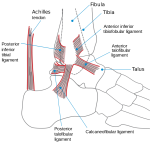YOUR PHYSIO
Condition directory
Ankle sprain
An ankle sprain is an injury to the tough bands of tissue (ligaments) that surround and connect the bones around the ankle joint. It typically happens when you accidentally twist or turn your ankle in an awkward way. This can stretch or tear the ligaments but can also affect tendons and blood vessels in the surrounding areas.
It is more common to damage the outside ligaments of your ankle when you have an inversion sprain (the bottom of your foot rolls inwards) but the inside ligaments can also be affected too.

Following an ankle injury you will normally experience pain, bruising and sudden swelling and you may find it difficult to weight bear on that side.
Ankle sprains are commonly associated with sports that include running, jumping and rapid changes of direction. However they can also happen in day to day life such as stepping of a curb when not paying attention or missing a step when walking up and down stairs.
Grading of Ankle Injuries
Sometimes a grading system is used to assess the severity of your ankle injury.
Grade 1: mild swelling/bruising with minimal ligament fibres damaged
Grade 2: moderate swelling/bruising with potentially some partial tearing of the ligament fibres. You may experience some mild instability initially
Grade 3: severe swelling/bruising with partial; earing or potentially full rupture of the ligaments. You will likely have trouble mobilising
If you are unable to put weight through your foot and ankle following an ankle sprain you should get checked by your GP or attend accident and emergency to make sure you haven’t sustained a broken bone. This would require a different management and would not be appropriate for physiotherapy in the early stages.
Early treatment
Mild sprains can be treated at home with the RICE principle;
- Rest the affected area for at least the first 48 hours. You may require crutches to avoid putting weight on your leg.
- Ice can help to reduced swelling and inflammation. Only use ice for 20 minutes at a time but do not apply directly to the skin, use a damp cloth between the ice and the injured area.
- Compression can help to prevent additional swelling. Wear an elastic compression bandage and remove for sleeping.
- Elevation can help to reduce swelling. Recline when you rest, and put your leg up higher than your heart. The compression should be snug to the skin but not restricting blood flow.
As soon as you feel able to move the ankle joint it is important to try to regain some movement in it to prevent joint stiffness and muscle loss.The following exercises are useful for early range of movement.
Further Rehabilitation
When the initial symptoms of pain and swelling start to subside, you will need to start some progressive exercise to ensure an optimal outcome. Below is an outline that may allow most people to return to their normal activities without any problems. Some who participate in sport involving changes of direction, jumping and landing may require more time or enhanced rehabilitation to achieve these goals. This support can be provided by seeking referral from your GP or completing a self-referral form.
- Weight bearing and walking as early as possible
- Maintain range of motion with some easy mobility exercises
- Basic strength exercise
- Starting to challenge you balance
- Gradually increase the distance you are walking and expose yourself to different types of terrain (incline/decline/uneven ground
- Practice jumping and landing
- Begin running and include changes of direction depending upon your rehabilitation goals
In most cases you are able to walk relatively comfortably after 1-2 weeks, can use it fully after 6-8 weeks and return to sport after 12 weeks. This is however dependent upon how severe the sprain is.
Prevention
Unfortunately, a number of people will suffer recurrent ankle sprains within the first 12 months following their initial injury. Some may go on to develop ankle instability. To minimise this risk it is important to incorporate some strength and balance exercises into a weekly routine. If you play regular sports with twisting and turning it may be wise to include this in a warm up. This can also be discussed with our physiotherapy team.